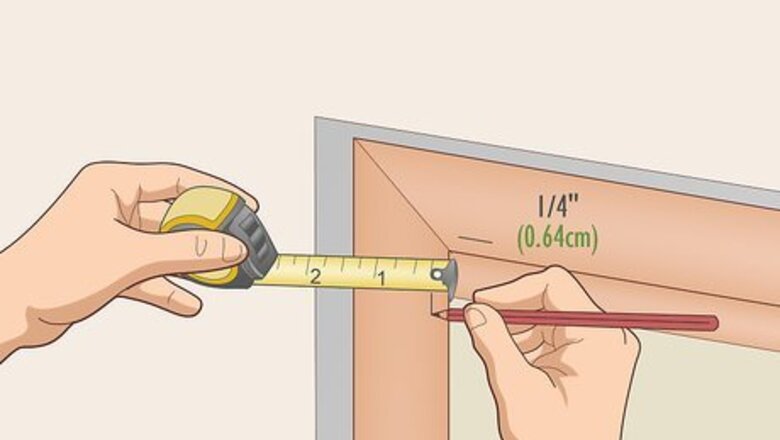
views
Measuring the Door Frame
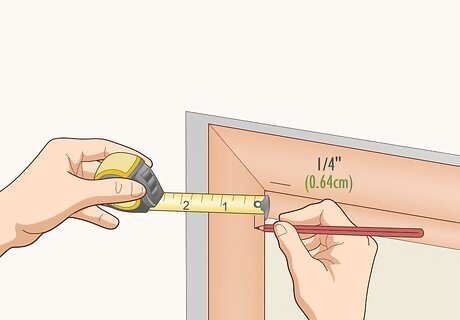
Draw reveal lines ⁄4 in (0.64 cm) in from the corners of the door frame. Place the end of a tape measure along the inside edge of the door frame’s top left corner. Extend the tape measure horizontally ⁄4 inch (0.64 cm) and draw a small line with a pencil. Then extend the tape measure vertically from the corner by the same distance and make another line. Repeat the process on the right side of the door frame so you know where to place the interior edges of the trim. Making reveal lines on the door frame ensures that you can open the hinges without them getting caught or damaging the trim pieces. You do not need to mark the bottom corners of the door frame.
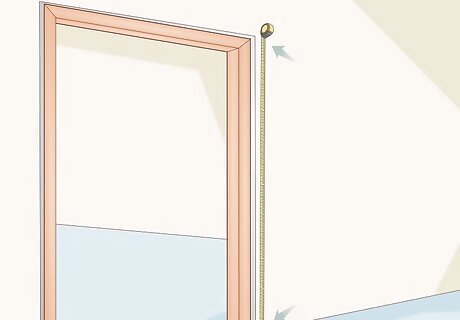
Measure each side from the floor to where they intersect the top line. Place the end of the tape measure against the floor on the right side of the door frame, and extend it up to the marks you drew in the corner. Make sure the tape measure stays perfectly vertical so you don’t get a skewed measurement. Then take the measurement for the right side of the door frame. Write down your measurements so you don’t forget them. Make sure to measure both sides rather than assuming they’re the same height since your floor or wall may be uneven.
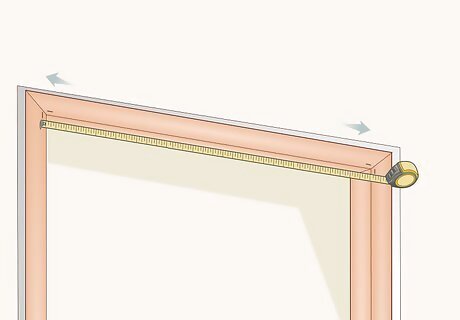
Find the horizontal distance between the marks at the top of the frame. Extend the tape measure from where the marks intersect on the left side to where they cross on the right side of the frame. Ensure the tape stays level horizontally to ensure you have an accurate measurement. Record your measurement so you’re able to reference it later. The measurement you find will be the length of the short side on a mitered piece of header trim.Variation: If you plan on using butt joints, which means you aren’t cutting miters into the corners, add twice the width of the trim to your measurement. For example, if you’re using 2 in (5.1 cm) trim pieces, you would add 4 inches (10 cm) to your final measurement.

Mark the lengths from your door frame on the thinnest edges of 3 trim pieces. Get enough trim pieces so you’re able to cut the pieces to size to fit around the door frame. Extend your tape measure to the same lengths as your measurements so you can draw lines on the trim. Make the marks on the thin edges of the trim since they’re installed closest to the door. Keep your marks about 4–5 inches (10–13 cm) from the end of the trim pieces since you’ll have to make angled cuts. You can buy door trim from your local hardware or home improvement store. Choose trim that’s a similar color to your door so it doesn’t clash.
Cutting the Trim Pieces
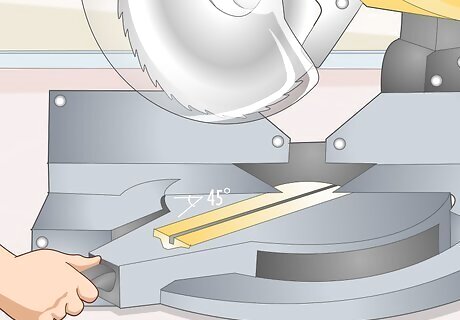
Set a miter saw to a 45-degree angle. Locate the locking lever on the miter saw, which you can usually find near the base of the saw arm. Undo the locking lever and turn the saw until it lines up with the 45-degree mark on the base. Lock the lever again to secure the saw so it doesn’t move or shift while you’re using it. You can buy or rent a power miter saw from your local hardware store. If you don’t want to use a power miter saw, look for a miter box that you can use with a regular handsaw.

Put on safety glasses, earplugs, and a facemask before using the saw. Get safety glasses that you cover your eyes completely in case there’s kickback when you use the saw. Opt for in-ear plugs or shop earmuffs since saws can make a lot of noise and damage your hearing over time. Miter saws can also create a lot of sawdust, so cover your nose and mouth with a facemask so you don’t breathe any in. Work in a well-ventilated area to help reduce the amount of dust in the air.Tip: Some miter saws have hose hookups so you can connect a shop vacuum to suck up the dust before it’s able to get airborne. Try hooking up your vacuum to the saw if you’re able to.
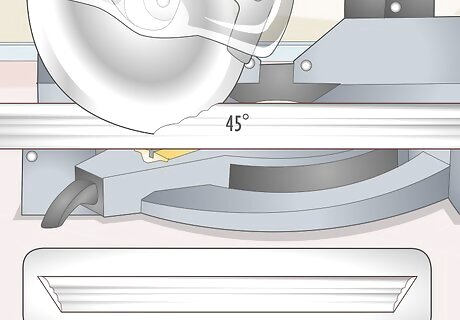
Cut 45-degree angles into both ends for the header trim so it looks like a trapezoid. Hold the trim tightly against the saw’s fence so it doesn’t move around. Line up the blade of the saw with the mark on the trim. Start the saw and slowly pull the handle down to cut through the trim. Turn off the saw and let the saw blade stop spinning before raising it back up. Turn the piece of trim 180 degrees and line up the blade with the second mark to cut it. The thinnest edge will be the shortest side and the thickest edge will be the longest. If you don’t want to rotate your piece of trim, you may also adjust the saw blade to a 45-degree angle in the opposite direction. If you plan on using butt joints or corner blocks, cut the ends of the header trim to 90-degree angles.
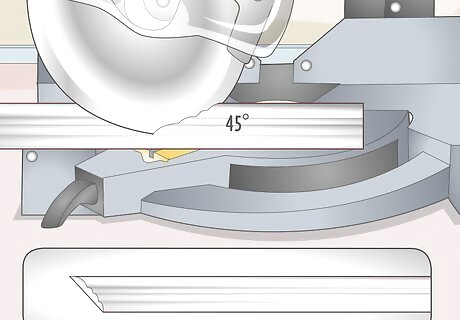
Make a 45-degree cut on the top end of each side piece. Hold the piece of trim for the left side of the frame tightly against the saw’s fence so it doesn’t move around while you cut it. Make sure the thinnest edge of the trim points toward you. Adjust the saw blade so it points at a 45-degree angle to the left. Pull the saw down to make your cut and let it stop spinning. Turn the saw blade so it’s at a 45-degree angle to the right for the piece of trim that goes on the right side. When you hold the left piece of trim vertically, the left edge should be the longest. If it’s not, then you had the saw blade oriented in the wrong direction. If you’re planning on using butt joints or corner blocks, then cut the top ends to a 90-degree angle instead.
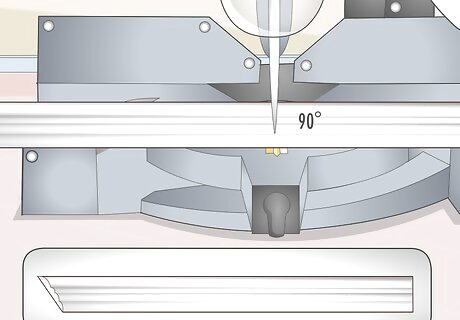
Saw the bottom ends of the side pieces to 90-degree angles. Adjust the blade of the saw so it’s at a 90-degree angle so your cuts are perfectly straight. Hold the trim piece against the saw’s fence and start the saw. Pull the handle down so it cuts through the trim piece before turning the blade off. Let the blade stop completely before raising the handle. Repeat the cut on the other side piece.
Attaching the Trim
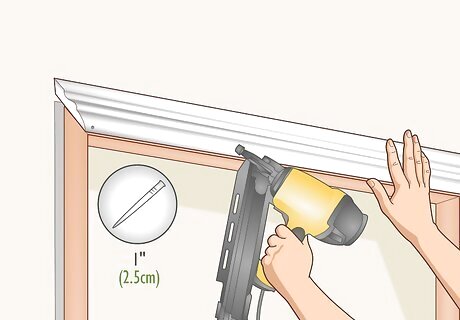
Secure the thin edge of the header trim with 1 in (2.5 cm) nails. Load 1 in (2.5 cm) finishing nails into an 18-gauge finishing nailer. Hold the piece of header trim above the door so the corners of the short edge line up with the marks on the frame. Drive the first nail 1 inch (2.5 cm) up and 1 inch (2.5 cm) over from the bottom left edge of the trim. Space the rest of the nails 1 foot (30 cm) apart along the length of the trim. You can buy or rent a nailer from your local hardware store. Avoid putting nails any closer than 1 inch (2.5 cm) from the edge since you could crack the trim. Never point a nailer at you or anyone else since it could cause serious injury.Variation: You can use a hammer if you don’t have access to a nailer. If you use a hammer, ask a helper to hold the piece of trim in place so it doesn’t shift around while you’re working.
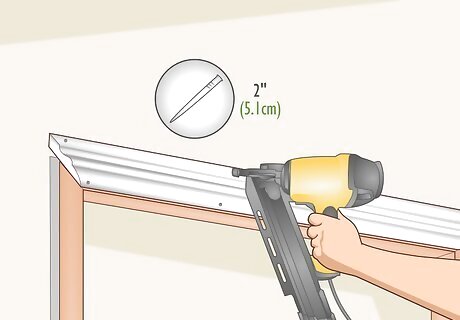
Drive 2 in (5.1 cm) finishing nails into the thick side of the trim. Remove the other nail cartridge from the nailer and replace it with a cartridge of 2 in (5.1 cm) nails. Place the first nail 1 inch (2.5 cm) in from the left side in the thicker part of the trim. Continue along the length of the trim, placing a nail every 1 foot (30 cm) until you reach the other side. Shorter nails won’t be able to go through the thick side of the trim.
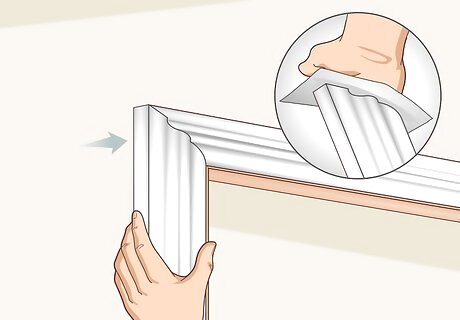
Fit the side pieces against the frame and trim them if they aren’t flush. Position the side pieces so the angled edge lines up perfectly with the side of the header trim. Push the ends together to ensure there aren’t any gaps between them. If you notice a small gap, note if it’s on the upper or bottom corner. Either sand or trim the corner opposite of the gap, checking the fit periodically until it’s flush. For example, if there is a slight gap at the top corner between the trim pieces, sand or trim the bottom corner to widen the angle until it’s flush. Be careful not to trim too much off of the side pieces, or else you may cause the pieces to look uneven.
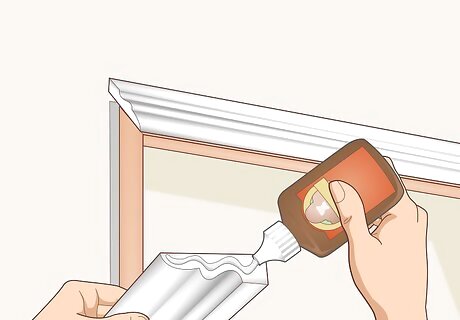
Apply wood glue to the ends of the side pieces and position them. Apply a zig-zag pattern of wood glue onto the angled end of the side piece and spread it around with your finger. Place the side pieces against the door frame so it’s flush with the edges of the header piece. Repeat the process on the other side piece. If wood glue oozes out between the pieces, wipe it off with a piece of paper towel.
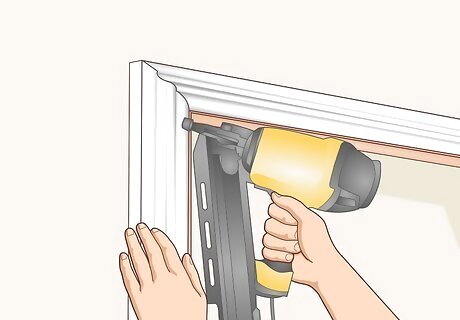
Nail the side pieces in with finishing nails. Drive 1 in (2.5 cm) finishing nails along the inside edge of the side pieces, starting 1 inch (2.5 cm) away from the top edge. Place the nails every 1 foot (30 cm) down the length of trim until you reach the bottom. Then secure the thicker exterior side of the trim with 2 in (5.1 cm) nails in the same way. You may also drive nails through the top of the header so they go into the angled ends of the side pieces if you want them held together more securely.

















Comments
0 comment